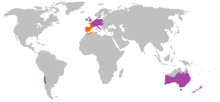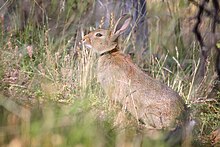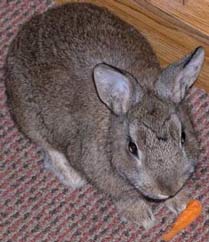European rabbit: Difference between revisions
m Disambiguate Invasive to invasive species using popups |
Francis Lima (talk | contribs) →The European Rabbit as an exotic pest: Added time of construction for Rabbit-Proof Fence |
||
| Line 64: | Line 64: | ||
The European Rabbit has been introduced as an [[exotic species]] into a number of environments, with baleful results to vegetation and local wildlife. Locations include the [[British Isles]] (from 1066 with the Norman invasion; as of November 2004 there were about 40 million European Rabbits in Britain), [[Laysan Island]] (1903) and [[Lisianski Island]] in the [[Hawaiian Islands]]; [[Macquarie Island]]; [[Smith Island (Washington)|Smith Island]], [[San Juan Island]] (around 1900) later spreading to the other San Juan Islands; [[Australia]] and [[New Zealand]].{{Citation needed|date=July 2008}} |
The European Rabbit has been introduced as an [[exotic species]] into a number of environments, with baleful results to vegetation and local wildlife. Locations include the [[British Isles]] (from 1066 with the Norman invasion; as of November 2004 there were about 40 million European Rabbits in Britain), [[Laysan Island]] (1903) and [[Lisianski Island]] in the [[Hawaiian Islands]]; [[Macquarie Island]]; [[Smith Island (Washington)|Smith Island]], [[San Juan Island]] (around 1900) later spreading to the other San Juan Islands; [[Australia]] and [[New Zealand]].{{Citation needed|date=July 2008}} |
||
Twenty-four European Rabbits were [[Rabbits in Australia|introduced to Australia]] in 1859 by estate owner [[Thomas Austin]] in [[Victoria (Australia)|Victoria]]. They soon spread throughout the country due to the lack of natural predators, widespread farming producing an ideal habitat, and mild Australian winters allowing them to breed year-round. Australia's equivalent to the rabbit, the [[Bilby]], was quickly pushed out by the rabbits. The bilbies are endangered, but are now making a comeback due to government protection. Australia built an immense "[[rabbit-proof fence]]". The European Rabbit can not only jump very high, but also burrow underground, making fencing especially futile. During the 1950s experiments with introduction of a virus, ''[[Myxomatosis cuniiculi]]'' provided some relief in Australia but not in New Zealand where the insect [[Vector (epidemiology)|vector]]s necessary for spread of the disease were not present. ''Myxomatosis'' can also infect pet rabbits of the same species. Today's remaining wild rabbits in Australia are largely immune to ''Myxomatosis''. The [[rabbit haemorrhagic disease virus]] which causes the [[rabbit haemorrhagic disease]] has been cleared as a safe form of [[biological control]] agent against the European Rabbit in [[Australia]] as well. |
Twenty-four European Rabbits were [[Rabbits in Australia|introduced to Australia]] in 1859 by estate owner [[Thomas Austin]] in [[Victoria (Australia)|Victoria]]. They soon spread throughout the country due to the lack of natural predators, widespread farming producing an ideal habitat, and mild Australian winters allowing them to breed year-round. Australia's equivalent to the rabbit, the [[Bilby]], was quickly pushed out by the rabbits. The bilbies are endangered, but are now making a comeback due to government protection. Between 1901 and 1907, Australia built an immense "[[rabbit-proof fence]]" to halt the westward expansion of the introduced rabbit population. The European Rabbit can not only jump very high, but also burrow underground, making fencing especially futile. During the 1950s experiments with introduction of a virus, ''[[Myxomatosis cuniiculi]]'' provided some relief in Australia but not in New Zealand where the insect [[Vector (epidemiology)|vector]]s necessary for spread of the disease were not present. ''Myxomatosis'' can also infect pet rabbits of the same species. Today's remaining wild rabbits in Australia are largely immune to ''Myxomatosis''. The [[rabbit haemorrhagic disease virus]] which causes the [[rabbit haemorrhagic disease]] has been cleared as a safe form of [[biological control]] agent against the European Rabbit in [[Australia]] as well. |
||
==Domesticated rabbits== |
==Domesticated rabbits== |
||
Revision as of 16:54, 30 June 2010
| European Rabbit[1] | |
|---|---|

| |
| Scientific classification | |
| Kingdom: | |
| Phylum: | |
| Class: | |
| Order: | |
| Family: | |
| Genus: | Oryctolagus Lilljeborg, 1873
|
| Species: | O. cuniculus
|
| Binomial name | |
| Oryctolagus cuniculus (Linnaeus, 1758)
| |

| |
| Range map | |
The European Rabbit (Oryctolagus cuniculus) is a species of rabbit native to south west Europe (Spain and Portugal). It has been widely introduced elsewhere often with devastating effects on local biodiversity. However, its decline in its native range (caused by the diseases myxomatosis and rabbit calicivirus as well as over-hunting and habitat loss) has caused the decline of its highly dependent predators, the Iberian Lynx and the Spanish Imperial Eagle. It is known as an invasive species for the fact it has been introduced to countries on all continents with the exception of Antarctica and Sub-saharan Africa, and caused many problems within the environment and ecosystems as well. Australia has the most problems with European Rabbits, since there is lack of predators to these animals there.
Portuguese National Authorities (ICNB) have classified the rabbit as Near Threatened in Portugal, whilst Spanish authorities recently re-classified the rabbit as Vulnerable in Spain[3].
In 2008, the European Rabbit was re-classified by the World Conservation Union (IUCN) as "Near Threatened" in its native range due to the extent of recent declines[4]
Rabbits are known by many names. Young rabbits are known by the names bunny, kit, or kitten. A male rabbit is called a buck, and a female rabbit is called a doe. A group of rabbits is known as a colony or a nest.[5] Colloquially, a rabbit may be referred to as a "coney" or a "bunny", though the former is archaic.
The European Rabbit is well-known for digging networks of burrows called warrens, where it spends most of its time when not feeding. Unlike the related hares (Lepus), rabbits are altricial, the young being born blind and furless, in a fur-lined nest in the warren, and they are totally dependent upon their mother.
Physical description

The European Rabbit is a small, grey-brown mammal ranging from 34–45 cm (13-18 inches) in length, and is approximately 1.3-2.2 kg (3-5 lb) in weight. As a lagomorph, it has four sharp incisors (two on top, two on bottom) that grow continuously throughout its life, and two peg teeth on the top behind the incisors, dissimilar to those of rodents (which have only 2 each, top and bottom). Rabbits have long ears, large hind legs, and short, fluffy tails. Rabbits move by hopping, using their long and powerful hind legs. To facilitate quick movement, a rabbit's hind feet have a thick padding of fur to dampen the shock of rapid hopping. Their toes are long, and are webbed to keep from spreading apart as the animal jumps.
Rabbit behavior in the wild
Rabbits are gregarious, social animals, living in medium-sized colonies known as warrens. Rabbits are largely crepuscular, being most active around dawn and dusk, although they are not infrequently seen active during the day. Rabbits are essentially mixed-feeders, both grazing and browsing, but grass is their primary food source.
The rabbit mating system is rather complex. Dominant males exhibit polygyny, whereas lower-status individuals (males and females) often form monogamous breeding relationships. Dominance hierarchies exist in parallel for both males and females, although dominant females are usually the mates of the dominant male. Males show considerable investment in the welfare of young, although much of this aspect of rabbit behavior is poorly understood.
Rabbits can be extremely aggressive in the wild, and competition between males can often lead to severe injury and death. Although hostile displays are used, and males often squirt urine on challengers as a form of territorial marking, the most common response to a challenge is immediate attack.[6] Rabbits use their powerful back legs as weapons, kicking at an opponent's underside, as well as biting and scratching with the front paws.
Rabbit burrows are excavated primarily by the female (doe), and usually during pregnancy. The doe digs short, blind tunnels as nesting stops, and is probably responsible as well for the excavation of most of the connecting tunnels.
Much of the modern research into wild rabbit behaviour was carried out in the 1960s by two research centres. One was the naturalist Ronald Lockley who maintained a number of large enclosures for wild rabbit colonies, with observation facilities, in Orielton in Pembrokeshire. Apart from publishing a number of scientific papers, he popularised his finding in a book The Private Life of the Rabbit.[6], which is credited by Richard Adams as having played a key role in his gaining "a knowledge of rabbits and their ways" that was espoused in the novel Watership Down. The other group was the Commonwealth Scientific and Industrial Research Organisation (CSIRO) in Australia where Mykytowycz & Myers performed numerous studies of the social behaviour of wild rabbits. Since the onset of myxomatosis and the decline of the significance of the rabbit as an agricultural pest, few large scale studies have been performed and many aspects of rabbit behaviour are still poorly understood.
Humans' relationship with rabbits

Humans' relationship with the European (sometimes called true) rabbit was first recorded by the Phoenicians earlier than 1000 BC, when they termed the Iberian Peninsula i-shaphan-ím (literally, the land of the hyraxes). This phrase closely resembles related modern Hebrew: i (אי) meaning island and shafan (שפן) meaning hyrax, plural shfaním (שפנים). Phoenicians called the local rabbits hyraxes because hyraxes resemble rabbits in some ways, and were probably more common than rabbits in their native land (the Levant) at the time. Hyraxes, like rabbits, are not rodents. According to one theory, Romans converted the phrase i-shaphan-ím, with influence by Greek Spania, to its Latin form, Hispania, which evolved into the modern Spanish word España, English Spain, and such other variations of modern languages. The precise meaning of shafan remains unclear, but the balance of opinion appears to indicate that the hyrax is indeed the intended meaning.[7]
The European Rabbit is the only species of rabbit to be domesticated. All pet breeds of rabbits, such as dwarf lops and angoras, are of this species. However, rabbits and humans interact in many different ways beyond domestication. Rabbits are an example of an animal that is treated as food, pet, and pest by members of the same culture. Urbanized European Rabbits descended from pets have become pest problems in some cities. For instance, the world's northernmost population of the species is now hosted by Helsinki, Finland, with an estimated 2500 animals at the end of 2006 and 5000 in autumn, 2007.[8] Finland's native lagomorphs are the European Hare and the Mountain Hare.
The European Rabbit as an exotic pest


The European Rabbit has been introduced as an exotic species into a number of environments, with baleful results to vegetation and local wildlife. Locations include the British Isles (from 1066 with the Norman invasion; as of November 2004 there were about 40 million European Rabbits in Britain), Laysan Island (1903) and Lisianski Island in the Hawaiian Islands; Macquarie Island; Smith Island, San Juan Island (around 1900) later spreading to the other San Juan Islands; Australia and New Zealand.[citation needed]
Twenty-four European Rabbits were introduced to Australia in 1859 by estate owner Thomas Austin in Victoria. They soon spread throughout the country due to the lack of natural predators, widespread farming producing an ideal habitat, and mild Australian winters allowing them to breed year-round. Australia's equivalent to the rabbit, the Bilby, was quickly pushed out by the rabbits. The bilbies are endangered, but are now making a comeback due to government protection. Between 1901 and 1907, Australia built an immense "rabbit-proof fence" to halt the westward expansion of the introduced rabbit population. The European Rabbit can not only jump very high, but also burrow underground, making fencing especially futile. During the 1950s experiments with introduction of a virus, Myxomatosis cuniiculi provided some relief in Australia but not in New Zealand where the insect vectors necessary for spread of the disease were not present. Myxomatosis can also infect pet rabbits of the same species. Today's remaining wild rabbits in Australia are largely immune to Myxomatosis. The rabbit haemorrhagic disease virus which causes the rabbit haemorrhagic disease has been cleared as a safe form of biological control agent against the European Rabbit in Australia as well.
Domesticated rabbits

The only rabbit to be widely domesticated is the European Rabbit. This rabbit has been extensively domesticated for food or as a pet. It was first widely kept in ancient Rome and was refined into a wider variety of breeds during the Middle Ages.
Domesticated rabbits have mostly been bred to be much larger than wild rabbits, though selective breeding has produced a wide range of breeds which are kept as pets and food animals across the world. They have as much colour variation among themselves as other household pets. Their fur is prized for its softness, and even today Angora rabbits are raised for their long soft fur, which is often spun into yarn. Other breeds are raised for the fur industry, particularly the Rex, which has a smooth velvet like coat and comes in a wide variety of colours and sizes.
In the middle-size breeds, the teeth grow approximately 125 mm (5 in) per year for the upper incisors and about 200 mm (8 in) per year for the lower incisors. The teeth abrade away against one another, giving the teeth a constantly sharp edge.
Reproduction
Rabbits are famed for their reproductive capabilities. Although certainly not the strongest, fastest, or smartest of the mammals, they have carved out a strong ecological niche through their rate of impregnation, due to the fact that female rabbits ovulate at the time of copulation. One striking example of rapid rabbit reproduction took place in Australia, where the 24 rabbits first introduced in 1859 had multiplied in number to over 600 million over the course of less than a century.[9][10]
The gestation cycle for a rabbit averages 31 days, although it can vary anywhere between 29 and 35 days. Litter sizes generally range between two to twelve rabbits. The young are born in a nesting burrow dug by the female, which she returns to once a day for four weeks in order for them to suckle.[11] The rabbit's reproductive abilities were the inspiration for the phrase "breeding like rabbits". They can reproduce from 3–4 months of age. They can produce 4-7 litters of offspring per year, a mature female can be pregnant continuously for 6–8 months. One single pair of mature rabbits are able to produce 30-40 offspring per year.
See also
- Rabbits in Australia, information on the European rabbit's status as a pest in Australia
- Rabbit show jumping, a sport involving domestic European rabbits
- House Rabbit Society, a non-profit organization dedicated to domesticated European rabbit care, education, information, and advocacy
- List of rabbit breeds
- American Rabbit Breeders' Association
References
- ^ Hoffman, R.S.; Smith, A.T. (2005). "Order Lagomorpha". In Wilson, D.E.; Reeder, D.M (eds.). Mammal Species of the World: A Taxonomic and Geographic Reference (3rd ed.). Johns Hopkins University Press. pp. 205–206. ISBN 978-0-8018-8221-0. OCLC 62265494.
- ^ Template:IUCN2008 Database entry includes a brief justification of why this species is Near Threatened
- ^ SECEM 2006 red list available at http://www.secem.es/PDFs/Lista%20roja%20SECEM.pdf
- ^ IUCN 2008 red list available at http://www.iucnredlist.org/details/full/41291/0
- ^ "The collective Noun Page". Retrieved 2008-01-30.
- ^ a b RM Lockley (1964), The Private Life of the Rabbit, Andre Deutsch
- ^ "The Camel, the Hare and the Hyrax, chapter 6" (PDF).
- ^ Kemppainen, Jouni K. (2007). "Kanit keskuudessamme (The rabbits among us)". Suomen Kuvalehti pages=76–83 language=Finnish.
{{cite journal}}: Missing pipe in:|journal=(help); Unknown parameter|month=ignored (help) - ^ "The virus that stunned Australia's rabbits". Retrieved 2007-06-21.
- ^ "Building a Rabbit "Bomb" in Australia" (PDF). SCDWS Briefs. 10 (4). 1995.
{{cite journal}}: Unknown parameter|month=ignored (help) - ^ Hofmann,H: Wild Animals of Britain and Europe, HarperCollins 1995, pg.118-119 ISBN 0-00-762727-0
- Reversing Rabbit Decline 2005 report concerning efforts to recover rabbits in Spain and Portugal, supported by the IUCN Lagomorph and Cat Specialist Groups
- IUCN Red List near threatened species
- Rabbits and hares
- Mammals of Europe
- Non-native fauna of the British Isles
- Fauna of Romania
- Fauna of Turkey
- Fauna of Greece
- Fauna of Russia
- Fauna of Poland
- Fauna of Bulgaria
- Fauna of Slovakia
- Fauna of the Czech Republic
- Fauna of Germany
- Fauna of Croatia
- Fauna of Austria
- Fauna of Slovenia
- Fauna of Italy
- Fauna of San Marino
- Fauna of Liechtenstein
- Mammals of Switzerland
- Fauna of Denmark
- Fauna of Sweden
- Fauna of the Netherlands
- Fauna of Luxembourg
- Fauna of Belgium
- Fauna of France
- Fauna of Monaco
- Fauna of Algeria
- Fauna of Morocco
- Fauna of Ceuta
- Fauna of Melilla
- Fauna of Gibraltar
- Fauna of Spain
- Fauna of Portugal
- Fauna of the United Kingdom
- Fauna of the Republic of Ireland
- Fauna of the Isle of Man
- Mammals of Great Britain

